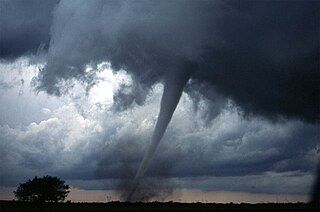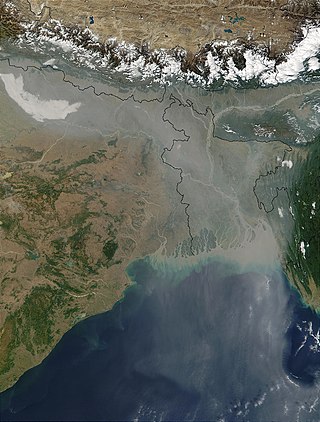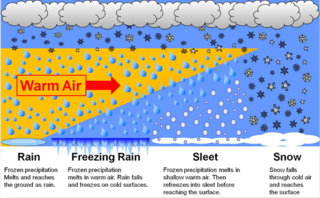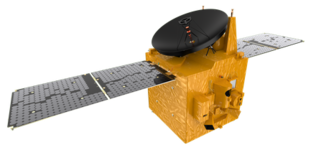
The United Arab Emirates is situated in the Middle East and West Asia, bordering the Gulf of Oman and the Persian Gulf, between Oman and Saudi Arabia; it is at a strategic location along the northern approaches to the Strait of Hormuz, a vital transit point for world crude oil. The UAE lies between 22°50′ and 26° north latitude and between 51° and 56°25′ east longitude. It shares a 19 km (12 mi) border with Qatar on the northwest, a 530 km (330 mi) border with Saudi Arabia on the west, south, and southeast, and a 450 km (280 mi) border with Oman on the southeast and northeast.

Weather modification is the act of intentionally manipulating or altering the weather. The most common form of weather modification is cloud seeding, which increases rainfall or snowfall, usually for the purpose of increasing the local water supply. Weather modification can also have the goal of preventing damaging weather, such as hail or hurricanes, from occurring; or of provoking damaging weather against an enemy, as a tactic of military or economic warfare like Operation Popeye, where clouds were seeded to prolong the monsoon in Vietnam. Weather modification in warfare has been banned by the United Nations under the Environmental Modification Convention.

In meteorology, precipitation is any product of the condensation of atmospheric water vapor that falls from clouds due to gravitational pull. The main forms of precipitation include drizzle, rain, sleet, snow, ice pellets, graupel and hail. Precipitation occurs when a portion of the atmosphere becomes saturated with water vapor, so that the water condenses and "precipitates" or falls. Thus, fog and mist are not precipitation but colloids, because the water vapor does not condense sufficiently to precipitate. Two processes, possibly acting together, can lead to air becoming saturated: cooling the air or adding water vapor to the air. Precipitation forms as smaller droplets coalesce via collision with other rain drops or ice crystals within a cloud. Short, intense periods of rain in scattered locations are called showers.

Cloud seeding is a type of weather modification that aims to change the amount or type of precipitation, mitigate hail or disperse fog. The usual objective is to increase rain or snow, either for its own sake or to prevent precipitation from occurring in days afterward.

Cloud condensation nuclei (CCNs), also known as cloud seeds, are small particles typically 0.2 µm, or one hundredth the size of a cloud droplet. CCNs are a unique subset of aerosols in the atmosphere on which water vapour condenses. This can affect the radiative properties of clouds and the overall atmosphere. Water vapour requires a non-gaseous surface to make the transition to a liquid; this process is called condensation.
This is a list of meteorology topics. The terms relate to meteorology, the interdisciplinary scientific study of the atmosphere that focuses on weather processes and forecasting.

In meteorology, the different types of precipitation often include the character, formation, or phase of the precipitation which is falling to ground level. There are three distinct ways that precipitation can occur. Convective precipitation is generally more intense, and of shorter duration, than stratiform precipitation. Orographic precipitation occurs when moist air is forced upwards over rising terrain and condenses on the slope, such as a mountain.

The following outline is provided as an overview of and topical guide to the field of Meteorology.

Rain is water droplets that have condensed from atmospheric water vapor and then fall under gravity. Rain is a major component of the water cycle and is responsible for depositing most of the fresh water on the Earth. It provides water for hydroelectric power plants, crop irrigation, and suitable conditions for many types of ecosystems.

Dubai features a tropical desert, hot arid climate. Dubai has two seasons – winter and summer. Rainfall has been increasing over the past few decades in the city accumulating to more than 130 mm (5.12 in) per year.

Dubai is situated on the Persian Gulf coast of the United Arab Emirates and is roughly at sea level. The emirate of Dubai shares borders with Abu Dhabi in the south, Sharjah in the northeast, and the Sultanate of Oman in the southeast. Hatta, a minor exclave of the emirate, is surrounded on three sides by Oman and by the emirates of Ajman and Ras Al Khaimah. The Persian Gulf borders the western coast of the emirate. Dubai is positioned at 25.2697°N 55.3095°E and covers an area of 1,588 sq mi (4,110 km2), which represents a significant expansion beyond its initial 1,500 sq mi (3,900 km2) designation due to land reclamation from the sea.
Dubai is a city in the United Arab Emirates and is recognized as one of the fastest-growing cities in the world. This rapid urbanization has led to many environmental issues, because of the harsh environment, paucity of local resources such as food, water, and building materials, and the unplanned manner of expansion.

The Emirates Mars Mission is a United Arab Emirates Space Agency uncrewed space exploration mission to Mars. The Hope probe was launched on 19 July 2020, and went into orbit around Mars on 9 February 2021.

International Center for Biosaline Agriculture (ICBA) is an international, not-for-profit applied agricultural research center with a unique focus on marginal environments. It identifies, tests and introduces resource-efficient, climate-smart crops and technologies that are best suited to different regions affected by salinity, water scarcity and drought. Through its work, ICBA aims to improve food security, nutrition and livelihoods of resource-poor farming communities around the world.

Environmental issues in the United Arab Emirates (UAE) are caused by the exploitation of natural resources, rapid population growth, and high energy demand. The continuing temperature rise caused by global warming contributes to UAE's water scarcity, drought, rising sea level, and aridity. The UAE has a hot desert climate, which is very vulnerable to the effects of climate change and contributes to worsening water scarcity, quality, and water contamination.

The Thailand Royal Rainmaking Project was initiated in November 1955 by King Bhumibol Adulyadej. Thai farmers repeatedly suffered the effects of drought. The king resolved to do something about it and proposed a solution to the dearth of rain: artificial rainmaking, or cloud seeding. The program is run by the Department of Royal Rainmaking and Agricultural Aviation.
The United Arab Emirates Research Program for Rain Enhancement Science (UAEREP) is a global research initiative offering a grant of US$5 million over a three-year period to be shared by up to five winning research projects in the field of rain enhancement.
Abdulla Ahmed Al Mandous is the current President of WMO. Al Mandous was elected as WMO president for a four-year term from 2023 to 2027 by the representatives of WMO's 193 member states and territories which convened in Geneva for the body's 19th annual congress from 22 May to 2 June, 2023. Al Mandous is also Director General of the National Center of Meteorology (NCM), the government entity that provides meteorological and seismological services and statistical data and information to various entities and the public in the United Arab Emirates to carry out their daily functions.

In April 2024, heavy rain severely impacted states in the Persian Gulf, causing flash flooding across the region. Several states recorded nearly a year's worth of rain in a single day. The floods had a significant impact across the region, with Oman and the United Arab Emirates being particularly affected, resulting in the deaths of at least 33 people, including 19 in Oman and 8 in Iran. Yemen, Bahrain, Qatar, and the Eastern Province of Saudi Arabia also experienced heavy rainfall and subsequent flooding.

On 16 April 2024, heavy rains caused floods in the United Arab Emirates, affected cities of mainly Dubai and Sharjah, the northern Emirates, and different areas of the Emirate of Ras Al Khaimah. According to the Emirati National Center for Meteorology, this was the country's heaviest rainfall recorded in 75 years. The floods in the Emirates were a part of the greater Persian Gulf floods.
















